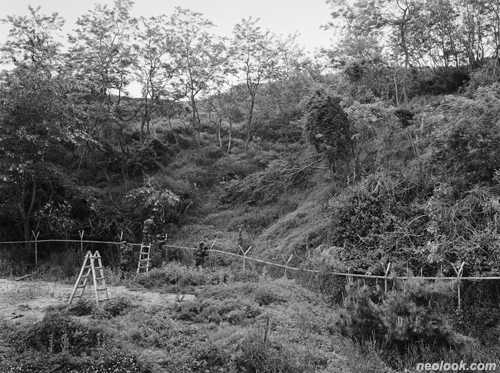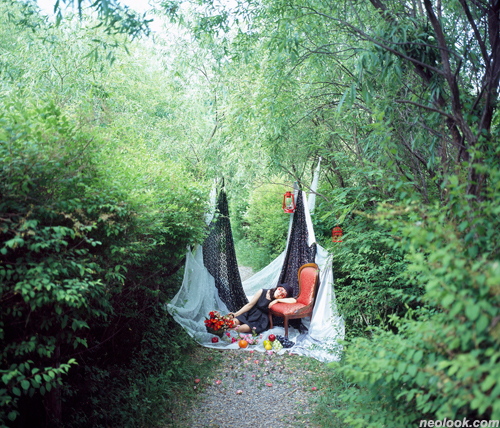- ● homepage
- ● archives
- ● restoration
- ● books
- ● big banners
- ● post board
- ■ neo's search
- ■ about us
- ■ 게재방법 안내
- 개인정보처리방침

- [email protected]
- Tel. 02_335_7922
- Fax. 02_335_7929
- 10:00am~04:30pm
- 월요일~금요일
- 3/3(월) 대체공휴일

우리안의 시간 Time Among Us
2012_0620 ▶ 2012_0626

- 김전기_155 miles #1, 해안초소_잉크젯 프린트_100×120cm_2008
초대일시 / 2012_0620_수요일_06:00pm
참여작가 / 김전기_김해정_박부곤_박미자_신현민_이선정
주관 / 스페이스 407
관람시간 / 10:00am~07:00pm
갤러리 이즈 GALLERY IS 서울 종로구 관훈동 100-5번지(인사동길 52-1) 3층 Tel. +82.2.736.6669 www.galleryis.com
우리안의 시간 - Time Among Us ● 사진은 시간을 담아낸다. 좀 더 엄밀하게 표현하자면 시간은 사진 안에 머물고 또한 흐른다. 물론 우리가 살아가는 동안만큼은 시간은 우리 안에 있다. 한편 사진은 그 매체적 본성으로 인해 우리 시간 너머의 영역을 지시하곤 한다. 지나가버린 과거의 한 순간부터, 무수하게 겹쳐진 현재, 그리고 다가 올 미래라는 미지의 영역에 이르기까지 사진은 이 모든 변화와 양상을 이미지의 스크린 위에 고정시켜 지시한다. 하루하루의 변화를 일기 쓰듯 기록함으로써 자신의 실존을 증명하려던 사르트르의 명저 구토의 주인공 로캉탱으로부터 이미지와 기억의 관계를 통해 단단한 시간의 지층을 와해시키고 있는 베르그손, 그리고 어머니의 죽음 이후 우연히 마주한 한 장의 사진으로 인해 사진의 본질과 그 존재론적 의미를 깨닫고 아파하는 바르트, 주인공이 마들렌 과자를 입에 넣는 순간 단 한번도 체험한 적 없는 형태의 과거가 영원성에서 떠오른다고 묘사함으로써 기억과 시간에 대한 일반적 견해를 거부하고 있는 프루스트에 이르기까지 우리의 삶은 시간이라는 절대적 무대 위에서 펼쳐진다. 이처럼 우리가 살아가는 현실세계에 대한 다양한 시각과 시간인식간의 관계를 사진으로 재해석한 전시가 『우리안의 시간』전이다. 본 전시에 참여한 6명은 각자의 시간 안에서 우리가 살아가는 이 시대의 공적, 사적인 기억뿐만이 아니라 다양한 삶의 모습들을 사진으로 기록, 표현하고 있다.

- 김전기_155 miles #3, 주문진_잉크젯 프린트_105×140cm_2010
김전기의 「155마일」프로젝트는 우리나라의 분단현실을 사진으로 기록한다. 강원도 동해안을 따라 설치된 철책선이 제거되는 장면과 일상의 모습이 교차하는 순간을 담아내고 있는 그의 사진들은, 우리의 삶속에 내재된 이데올로기와 현실상황을 재고하도록 한다. 철책선이라는 녹슨 기념비는 60년이라는 시간의 누적을 그리고 155마일은 넘어설 수 없는 현실장벽에 대한 심리적, 물리적 제약을 암시하고 있다.

- 김해정_꿈의 방-3_C 프린트_80×120cm_2011

- 김해정_꿈의 방-5_C 프린트_80×120cm_2011
그리고 어떤 공간속을 홀로 떠도는 환영들을 추적하고 있는 김해정의 「꿈의 방」연작은 꿈과 기억의 이미지들로 가득하다. 사진에 등장하는 존재들은 작가의 요구에 의해 전환된 이미지의 파편에 다름 아니다. 작가가 설정한 시간동안 그녀의 이미지들은 시공을 넘어 찰나처럼 머물다 사라진다. 이 사진속의 존재들은 그녀의 시간으로 소환된 기억과 동경의 이미지들이며, 지극히 사적이고 서정적인 이 사진들은 미묘한 심리 드라마를 연출하고 있다.

- 박미자_The forgotten-1, Phone_C 프린트_120×120cm_2012

- 박미자_The Forgotten-2, Wallet_C 프린트_120×120cm_2012
한편 박미자의 시간은 타인의 기억에 의존한다. 「잊다」연작은 과거 누군가의 소지품었던 핸드폰, 지갑, 도장등을 하나의 화면 위에 병치시켜 보여준다. 오랫동안 사람의 손길이 닿아있던 이 물건들에는 개인의 취향과 흔적들이 고스란히 남아있다. 이 수집품들을 통해 유추 가능한 익명의 주인과 물건 간의 관계에서 소비, 유행, 자본이라는 거대한 구조는 유행이 지나면 버려지고 대체되는 수많은 소모품처럼 너무나도 하찮고 일회적으로 묘사된다. 즉, 이 시대의 주체는 소비를 통해 증명되고 또한 쉽게 잊혀질 수 밖에 없음을 환기시킨다.

- 박부곤_Urban light-3_C 프린트_120×150cm_2012

- 박부곤_Tracking-1_C 프린트_120×150cm_2012
박부곤의 「진화의 땅」프로젝트는 산업개발현장과 그 주변 환경을 기록한 결과물이다. '대지, 밤빛과 트래킹'에서 현재는 미래를 위해 존재하는 필요조건이며 진행중에 있는 불완전한 시공간이다. 작가는 땅이라는 익숙한 대상물을 통해 자연환경의 순환과 유지라는 근원적 성찰과 더불어서 발전과 진보의 그림자에 가려진 불편한 진실을 누설한다.

- 신현민_Fragment-2_C 프린트_120×110cm

- 신현민_Fragment-1_C 프린트_64×122cm_2012
신현민의 「파편」연작은 도시의 구조와 디자인에 주목한다. 마치 실현 불가능한 청사진처럼 인간들은 이상적인 도시를 꿈꾸고 건설한다. 작가의 사진 속에 도시는 무수하게 잘라지고 덧 붙여지기를 반복하는 조각파편이다. 특정 지역과 장소를 수차례 반복 촬영한 후 디지털로 재구성하는 행위를 통해서 작가는, 도시가 마치 레고 블록처럼 교체, 전환 가능한 허구적 구조에 불과함을 드러낸다. 이 세계를 지탱하는 역사라는 엄격한 기준과 질서 조차도 해체, 와해시켜버리고 있다.

- 이선정_The set-3_잉크젯 프린트_100×120cm_2012
마지막으로 이선정의 「세트」연작은 연극적이다. 자신이 화자로 등장하는 이 사진들에서 작가는 다양한 모습으로 변화한다. 자신의 얼굴을 마스크로 가린 채, 떠나온 곳을 응시하고 있는 사진 속 캐릭터는 현대사회에서 자신의 존재를 지운채로 연기하듯 살아가야 하는 우리들의 슬픈 자화상을 대변한다. 그러하기에 숲길에 형형색색의 천으로 가상의 세트를 세우고 그 내부로 걸어 들어가는 순간이야말로, 절대적 시공간의 벽을 허물고 자신의 세계로 회귀할 수 있는 작가적 염원의 반영된 때이다. ● 『우리안의 시간』전은 사진작가 6명의 시선을 통해서 우리의 삶을 구성하고 있는 선험적 조건들에 대한 인식과 성찰 그리고 새롭게 재편, 구축되는 현실의 다층적 구조를 펼쳐 보인다. 사진은 시간을 기록하고 재현하는 가장 확실한 매체이다. 그러나 이들의 작품에서 우리는 시간의 흐름 자체를 포착하려는 원론적 역할보다는 소멸, 생성, 순환 또한 결국 작가들이 한정한 범주와 언어 안에서만 재현 가능함을 엿보게 된다. 이들에게 시간은 고정되어있지 않은 채 파편화되거나 혼재된 모습으로 나타난다. 또한 작가들의 작품에서 역사와 시간의 절대적 관계는 쉽게 허물어지고 변화하는 가변적 양태이다. 사진이라는 현대의 시간기계를 통해 망각에 대항하고 때론 기억에 적극 개입하며 자신의 존재를 시간성의 억압으로 부터 탈주시키려는 작가적 의지는, 전시장을 혼란과 전유가 뒤섞인 공간으로 변모시킬 것이다. ■ 스페이스 407

- 이선정_The set-17_잉크젯 프린트_100×120cm_2012
Photography captures (moments in) time. Technically speaking, time is preserved in the photographs and also flows in them. While we are living, 'time is among us.' Meanwhile, photographs indicate the territory beyond our time for its natureas a medium. From a moment in the past, the numerously overlapping present to the upcoming future, photographs fix all these changes and aspects on the screen. From Roquentin who tried to prove his existence by writing his personal diary about daily changes in the novel 'Nausea (La Nausee, 1938)' written by Jean-Paul Sartre, Henri Bergson who breaks down the solid strata of time through the relation between images and memories, Barthes who suffered from realizing the nature and existential meaning of photography through one photograph he came across after his mother's death, to Proust who denied the general opinion of memories and time by describing that as soon as his main character puts the madeleine in his mount, the past he has never experienced emergesfrom eternity, our life unfolds on the absolute stage of time. Likewise, the exhibition 『Time among us』 reinterprets the various perspectives on the real world and the relations involving time recognition through photography. The six participating artists document and express diverse images of life, as well as the public and private memories of the times we live, from their own point of view. ● Kim Jeon-Ki's 「155 miles」 project demonstrates Korea's divided reality through photographs. His photographs show the scenes of barbed wires being removed along the East Coast in Gangwon Province, overlapped with daily images, which allows us to reflect on ideology in our life and reality. The rusty monument of barbed wires implies the accumulated time of 60 years, and 155 miles indicates psychological and physical limits against the barrier of reality that cannot be overcome. ● Kim Hae-Jung's 「The Room of Dream」 series, which tracks the illusions roaming in some space, is filled with the images of dreams and memories. Existent things in her photographs are no more than the fragments of images that were produced by the artist's demand. Within the time frame that was set by Kim, the images stay momentarily and then disappear beyond time and space. The existences are the images of memories and aspirations that are recalled by her time, and her private and lyrical atmosphere produces an eccentric psychological drama. ● On the contrary, Park Mi-Ja's time depends on others' memories. Her 「The Forgotten」 series displays somebody's old possessions, such as a mobile phone, a purse and a stamp, on a screen in parallel. The traces of personal touch and tastes remain intact in these objects that were used by people for some time. The relationship between anonymous owners and objects that can be inferred through these collections indicate that the gigantic structure of consumption, trends and capital is a trivial disposable, which is consumed, abandoned and replaced by a new thing after the trend becomes old-fashioned. This reminds us of the fact that people prove themselves through consumption and forgotten easily in modern times. ● Bookon Park's 「The Land of Evolution」 is a collection of documentary photographs of industrial construction sites and surrounding areas. In 「Land」, 「Urban Light」 and 「Tracking」, the present is a prerequisite for the future and an incomplete time and space in progress. The artist reveals inconvenient truth hidden in the shadow of development and advancement through the familiar object - land, as well as the fundamental reflection on cycle and sustainability of the natural environment. ● In 「Fragment」 series, Shin Hyun-Min pays attention to the urban structure and design. People dream of and construct an ideal city like an infeasible blueprint. The city in his photographic work is a collection of fragments that are cut and pasted in a repeated fashion. By taking pictures of a specific area andplace numerous times and digitally retouching them, the artist discloses that the city is a mere fictional structure, which is replaceable and interchangeable like Lego blocks. He even disassembles and disintegrates a stringent standard and order of history that sustains the world. ● Lastly, Lee Sun-Jung's 「The Set」 series is play-like. The artist transforms herself to various images in the photographs where she acts as a narrator. The character who stares at the place she left behind with a mask on her face represents our sad portrait to live our life acting as if there were no place for our existence in modern times. Therefore, the moment when she is entering the inside of a virtual set that she established with colorful textiles in the forest path is when the artist's wish to return to her world beyond the absolute boundary of time and space is reflected. ● The exhibition 『Time among us』 displays a multi-layered structure of reality that is recognized and reflected and then freshly reorganized and established for transcendental conditions of our life, through the different lenses of six photographers. Photography is the most certain medium to document and represent time. However, in their artworks, we can catch a glimpse of the reproduction of birth, deathand cycle within their limited scopes and languages, rather than a fundamental role of capturing the passage of time. To them, time is not fixed, but in a fragmented or mixed pattern. In addition, the absolute relation between history and time is in the variable form that easily crumbles and changes in their works of art. Their artistic intention to confront oblivion, intervene in memories at times and set their existence from the oppression of time through photography - a modern 'time machine' -transforms the exhibition hall to a place of confusion and appropriation. ■ SPACE 407
Vol.20120620h | 우리안의 시간 Time Among Us展
